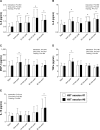High-intensity interval training induces a modest systemic inflammatory response in active, young men
- PMID: 24520199
- PMCID: PMC3920540
- DOI: 10.2147/JIR.S54721
High-intensity interval training induces a modest systemic inflammatory response in active, young men
Abstract
1) the extent to which an acute session of high-intensity interval training (HIIT) increases systemic inflammatory cytokines and chemokines, and 2) whether 2 weeks of HIIT training alters the inflammatory response. Eight recreationally active males (aged 22±2 years) performed 2 weeks of HIIT on a cycle ergometer (six HIIT sessions at 8-12 intervals; 60-second intervals, 75-second active rest) at a power output equivalent to 100% of their predetermined peak oxygen uptake (VO2max). Serum samples were collected during the first and sixth HIIT sessions at rest and immediately, 15, 30, and 45 minutes post-exercise. An acute session of HIIT induced significant increases in interleukin (IL)-6, IL-8, IL-10, tumor necrosis factor-α, and monocyte chemotactic protein-1 compared with rest. The concentrations of interferon-γ, granulocyte macrophage-colony-stimulating factor, and IL-1β were unaltered with an acute session of HIIT Two weeks of training did not alter the inflammatory response to an acute bout of HIIT exercise. Maximal power achieved during a VO2max test significantly increased 4.6%, despite no improvements in VO2max after 2 weeks of HIIT. These data suggest that HIIT exercise induces a small inflammatory response in young, recreationally active men; however, 2 weeks of HIIT does not alter this response.
Keywords: cycle ergometer; exercise training; inflammatory cytokines.
Figures


Similar articles
-
High-Intensity Interval Training Is Associated With Alterations in Blood Biomarkers Related to Brain Injury.Front Physiol. 2018 Sep 28;9:1367. doi: 10.3389/fphys.2018.01367. eCollection 2018. Front Physiol. 2018. PMID: 30323770 Free PMC article.
-
Six high-intensity interval training sessions over 5 days increases maximal oxygen uptake, endurance capacity, and sub-maximal exercise fat oxidation as much as 6 high-intensity interval training sessions over 2 weeks.J Sport Health Sci. 2021 Jul;10(4):478-487. doi: 10.1016/j.jshs.2020.06.008. Epub 2020 Jun 18. J Sport Health Sci. 2021. PMID: 32565243 Free PMC article.
-
Chronic effects of high-intensity interval training on postprandial lipemia in healthy men.J Appl Physiol (1985). 2019 Dec 1;127(6):1763-1771. doi: 10.1152/japplphysiol.00131.2019. Epub 2019 Oct 17. J Appl Physiol (1985). 2019. PMID: 31622161
-
Effect of High-Intensity Interval Training Versus Sprint Interval Training on Time-Trial Performance: A Systematic Review and Meta-analysis.Sports Med. 2020 Jun;50(6):1145-1161. doi: 10.1007/s40279-020-01264-1. Sports Med. 2020. PMID: 32034701
-
Effects of different protocols of high intensity interval training for VO2max improvements in adults: A meta-analysis of randomised controlled trials.J Sci Med Sport. 2019 Aug;22(8):941-947. doi: 10.1016/j.jsams.2019.01.013. Epub 2019 Jan 29. J Sci Med Sport. 2019. PMID: 30733142
Cited by
-
The effect of fitness level on cardiac autonomic regulation, IL-6, total antioxidant capacity, and muscle damage responses to a single bout of high-intensity interval training.J Sport Health Sci. 2018 Jul;7(3):363-371. doi: 10.1016/j.jshs.2016.11.001. Epub 2016 Nov 3. J Sport Health Sci. 2018. PMID: 30356659 Free PMC article.
-
Effects of a high-intensity interval training program versus a moderate-intensity continuous training program on maximal oxygen uptake and blood pressure in healthy adults: study protocol for a randomized controlled trial.Trials. 2016 Aug 18;17:413. doi: 10.1186/s13063-016-1522-y. Trials. 2016. PMID: 27538896 Free PMC article. Clinical Trial.
-
The Salzburg 10/7 HIIT shock cycle study: the effects of a 7-day high-intensity interval training shock microcycle with or without additional low-intensity training on endurance performance, well-being, stress and recovery in endurance trained athletes-study protocol of a randomized controlled trial.BMC Sports Sci Med Rehabil. 2022 May 7;14(1):84. doi: 10.1186/s13102-022-00456-8. BMC Sports Sci Med Rehabil. 2022. PMID: 35526065 Free PMC article.
-
High-Intensity Interval Training Is Associated With Alterations in Blood Biomarkers Related to Brain Injury.Front Physiol. 2018 Sep 28;9:1367. doi: 10.3389/fphys.2018.01367. eCollection 2018. Front Physiol. 2018. PMID: 30323770 Free PMC article.
-
Short-Term High- and Moderate-Intensity Training Modifies Inflammatory and Metabolic Factors in Response to Acute Exercise.Front Physiol. 2017 Oct 31;8:856. doi: 10.3389/fphys.2017.00856. eCollection 2017. Front Physiol. 2017. PMID: 29163201 Free PMC article.
References
-
- American College of Sports M. Thompson WR, Gordon NF, Pescatello LS. ACSM’s Guidelines for Exercise Testing and Prescription. Philadelphia: Lippincott Williams and Wilkins; 2010.
-
- Burgomaster KA, Heigenhauser GJ, Gibala MJ. Effect of short-term sprint interval training on human skeletal muscle carbohydrate metabolism during exercise and time-trial performance. J Appl Physiol. 2006;100(6):2041–2047. - PubMed
-
- Burgomaster KA, Hughes SC, Heigenhauser GJ, Bradwell SN, Gibala MJ. Six sessions of sprint interval training increases muscle oxidative potential and cycle endurance capacity in humans. J Appl Physiol. 2005;98(6):1985–1990. - PubMed
-
- Rodas G, Ventura JL, Cadefau JA, Cusso R, Parra J. A short training programme for the rapid improvement of both aerobic and anaerobic metabolism. Eur J Appl Physiol. 2000;82(5–6):480–486. - PubMed
LinkOut - more resources
Full Text Sources
Other Literature Sources
Research Materials

